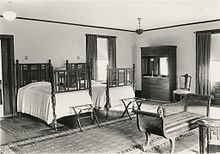Mary Garrett
Mary Elizabeth Garrett (born March 5, 1854 in Baltimore , Maryland , † April 3, 1915 in Montgomery County (Maryland) ) was an American suffragist and philanthropist . She is one of the greatest benefactors of American higher education for women.
life and work
Garrett was the third child and only daughter of Rachel Ann Harrison and philanthropist John W. Garrett , who was president of the Baltimore and Ohio Railroad . She went to Miss Kummer School when she was twelve, where she met two lifelong friends, Julia Rebecca Rogers , nicknamed "Dolly" and Elizabeth King, nicknamed "Bessie". Dolly was the daughter of a wealthy iron and steel merchant from Baltimore, Bessie came from a famous Quaker family and was the daughter of an employee of Garrett's father. Garrett was initially enthusiastic about school life, but she got bored because of the school's conservative attitude towards girls' education. The headmaster prevented the girls from studying science. In response to the restrictive school policy, the three girls formed their own study group and, to the horror of everyone, dissected a rat to learn life sciences. Disappointed with his own school experience, Garrett left school at the age of seventeen and taught himself at home, reading classics. She learned fluent Italian and French and practiced German and Greek. She learned about trading and running a railroad company from her father and later worked as his personal secretary. She had the opportunity to meet many eminent business people in America, including Andrew Carnegie , JP Morgan , William Henry Vanderbilt and Jay Gould. This experience gave her the ability to become an effective negotiator and business woman. She met regularly with a group of young women in Baltimore to discuss literature, philosophy, and social issues. This group referred to itself as the "Friday Night" group because they met every other Friday of the month. The group included Bessie King, Mamie Gwinn, Martha Carey Thomas, and Julia Rogers. They founded the Bryn Mawr School for girls in Baltimore in 1885. This was an elite prep school for girls named after the famous Bryn Mawr College, Pennsylvania women's college. Garrett was the new school's main financial backer. At Bryn Mawr College, Garrett donated $ 10,000 a year to help pay all the bills of the college on condition that Martha Carey Thomas became president. Garrett redesigned the dean's office and commissioned Frederick Law Olmsted , designer of New York's Central Park and Stanford University campus, to plan the campus.
At the age of 22, she asked Daniel Coit Gilman , the first president of Johns Hopkins University , for special permission to enroll at Johns Hopkins University, which she was denied due to her status as a woman. When the Johns Hopkins School of Medicine was under construction in the late nineteenth century, Garrett and her friends formed the Women's Medical School Fund Committee and promised to make up for the university's financial deficit, provided women were admitted on equal terms with men. Garrett set the accreditation standards in line with the highly acclaimed European standards for medical education, and Gilman was very concerned about the stricter academic standards. In the late nineteenth century, most of the medical schools in the United States were small, profitable corporations owned by the faculties. The medical schools sold medical degrees to whoever paid the tuition. No previous education was required for admission. At Harvard University and the University of Pennsylvania, academic standards had been raised earlier and led to a decline in sales as fewer students qualified for admission. Gilmann tried in vain to convince Garrett to lower their standards. Through negotiation, Garret eventually agreed to change two paragraphs of her terms and conditions, stressing that her gift terms would not affect the operation of the university. Garrett forced the university to admit women on an equal footing with men and increased admission requirements. This made the Johns Hopkins School of Medicine the first coeducational medical school for university graduates in the United States. In October 1893, the Johns Hopkins University School of Medicine accepted three students for the first time after accepting Garrett's terms on her gift. By June 21, 2000, 1,547 women had graduated from Johns Hopkins University's medical school. Garrett's funding and its clearly defined terms not only opened medical education for America's women, but also made Johns Hopkins the first modern medical school in the United States. Like many other suffragists of the nineteenth century, Garrett did not marry, but had a lifelong and emotional relationship with Thomas. In her later years, she worked with long-time friends Susan B. Anthony and Anna Howard Shaw to secure the right to vote for women in the United States.
She spent her final years at Bryn Mawr College with Mary Carey Thomas, with whom she shared the same deanship at Bryn Mawr. She died of leukemia at Bryn Mawr College at the age of 61 and was buried next to her father in Green Mount Cemetery, Baltimore. She bequeathed most of her funds and property, including the Mount Vernon mansion, to Martha Carey Thomas in her will.
literature
- Alan Mason Chesney: The Johns Hopkins Hospital and the Johns Hopkins School of Medicine, A Chronicle, Johns Hopkins Press, 1943.
- Helen Lefkowitz Horowitz: The Power and Passion of M. Carey Thomas, Alfred A. Knopf, 1991.
- Kathleen Waters Sander: Mary Elizabeth Garrett: Society and Philanthropy in the Gilded Age, Johns Hopkins Press, 2008.
Web links
| personal data | |
|---|---|
| SURNAME | Garrett, Mary |
| ALTERNATIVE NAMES | Garrett, Mary Elizabeth |
| BRIEF DESCRIPTION | American suffragist and philanthropist |
| DATE OF BIRTH | March 5, 1854 |
| PLACE OF BIRTH | Baltimore , Maryland |
| DATE OF DEATH | April 3, 1915 |
| Place of death | Montgomery County, Maryland |



